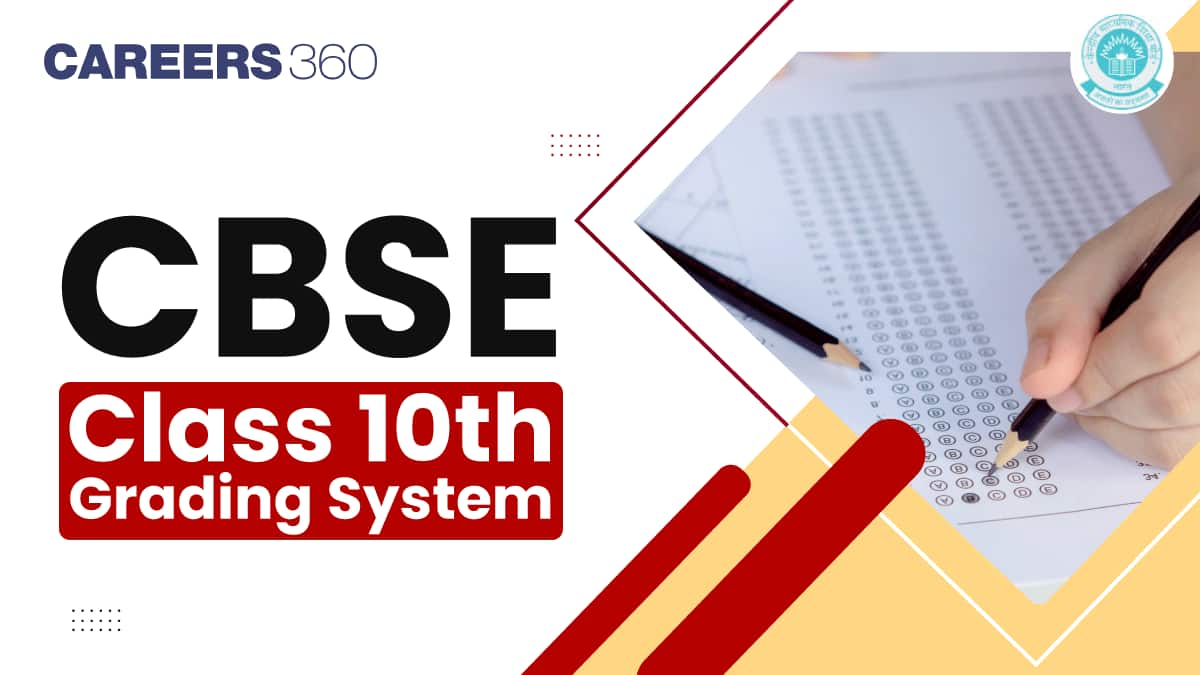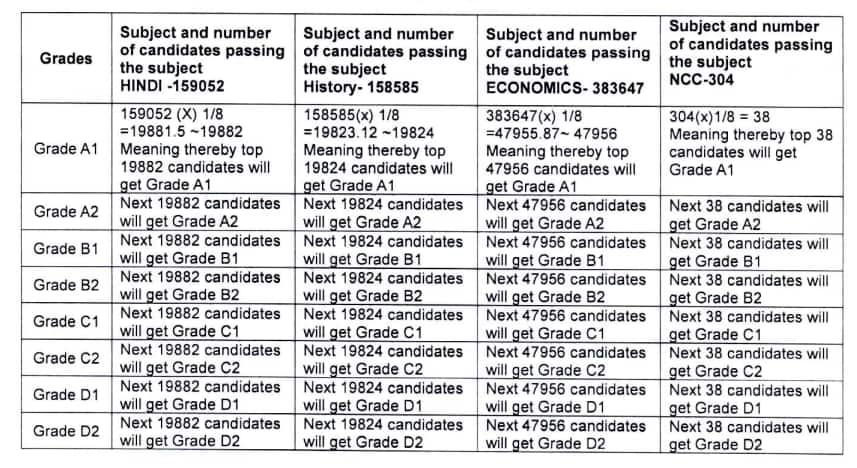CBSE Class 10 CGPA to Percentage Calculator, Marks to Grades: 10th Grading System 2025
CBSE Class 10th Exam Date:01 Jan' 26 - 14 Feb' 26
The Central Board of Secondary Education (CBSE) awards grades to students for all subjects, along with the marks obtained by them in the CBSE 10th board exams. These CBSE Class 10 grades are assigned and reflected in the final CBSE 10th result marksheet, which is issued to the students. CBSE follows a ‘Relative Grading System,’ which is considered to be a more scientific approach than an Absolute Grading System. The main difference between the Relative grading and the Absolute grading system is that in the latter, grades are determined based on pre-determined cut-off scores.
This Story also Contains
- CBSE Class 10 Grading System 2026
- How are Candidates Divided into Groups to Award the CBSE X Grades?
- Details About CBSE Class X Grading Scale

In simple language, one can say that grades are not determined based on a marks range such as 91 to 100, 81 to 90, etc, in the Relative Grading system. The Relative CBSE 10th grading system adopted by CBSE is more scientific and removes dependency on rigid cut-offs. It provides a more balanced assessment method. In this article, we have discussed the CBSE Class X grading system 2026 in detail.
CBSE Class 10 Grading System 2026
For awarding grades to students, the CBSE Board follows a rank order, as mentioned in the table below. Students who have passed the CBSE Class 10 board exams are divided into 8 groups and awarded grades. The division of group details can be checked in the table below:
CBSE Class 10th Grading System (9-Point Scale)
Grades | Particulars |
A-1 | Top 1/8th of the passed candidates |
A-2 | Next 1/8th of the passed candidates |
B-1 | Next 1/8th of the passed candidates |
B-2 | Next 1/8th of the passed candidates |
C-1 | Next 1/8th of the passed candidates |
C-2 | Next 1/8th of the passed candidates |
D-1 | Next 1/8th of the passed candidates |
D-2 | Next 1/8th of the passed candidates |
E* | *Essential Repeat |
CBSE 10th Grading System for Art Education
For Art Education in CBSE Class 10, a five-point grading system is followed. The grade allocation and its connotations are mentioned in the table below:
Grade | Connotation |
A | Exemplary |
B | Proficient |
C | Developing |
D | Emerging |
E | Beginner |
How are Candidates Divided into Groups to Award the CBSE X Grades?
The CBSE Board needs to divide students into 8 equal groups and award grades to them. Minor adjustments are made in cases of ties. The proportion of candidates is nearly the same in all groups.
Students who obtain the same score are kept in the same group and awarded the same grade.
It should be noted that any candidate who obtains equal scores in any 2 subjects may not necessarily get the same grade. This is how the Relative Grading system works.
As per CBSE’s official notice, the grading method is used in subjects where more than at least 500 candidates are declared pass.
In subjects where the number of passed students is less than 500, a different grading system is adopted by the board. The demonstration of how the CBSE Class X grading system works can be seen in the image given below:
CBSE Class 10 Grading System Hypothetical Example

Details About CBSE Class X Grading Scale
For awarding grades in CBSE 10th external exams, a 9-point grading system is used, which ranges from A1 to E grade.
For internal exams or internal assessment, a five-point grade scale is used, which ranges from A to E grades only.
For theory subjects and practical components, students get both numerical scores and grades.
How are Merit Certificates Awarded based on Grades Obtained in CBSE Class 10?
The top 0.1% of students in each subject get a merit certificate.
Certificates are not awarded for subjects where the number of students who passed the subject is less than 500.
Students who obtain the same scores in any subject are awarded certificates if there is a tie.
Also, Check:
Frequently Asked Questions (FAQs)
Students need at least a D-2 grade to be declared pass in the CBSE 10th exams.
Once CBSE 10th results are announced, students cannot change their grades.They can, however, take improvement exams and then the new score obtained may change their original grade.
A student may not necessarily get the same grade in 2 subjects even if the marks obtained are the same. This is because CBSE follows a Relative grading system and grades awarded are based on competition level in the respective subjects.
Questions related to CBSE Class 10th
On Question asked by student community
Hi! If you’re looking for the Class 11 English half yearly question paper for 2025-26 (CBSE board), you’ll find the right resource once you check the link provided from Careers360. Solving previous or sample papers is a smart way to prepare, as it helps you understand the question types, marking scheme, and important topics. This practice will boost your confidence and help you manage your time well in the actual exam.
https://school.careers360.com/boards/cbse/cbse-class-11-half-yearly-sample-papers-2025-26
Hi dear candidate,
Could you please specify us the board of education for which you need the half yearly question papers of class X so that we can help you further.
Below are few links which may help you and it has all the subjects with English as well:
CBSE Class 10 Half Yearly Exam Question Paper 2025-26 with Answer Key & Analysis
ICSE Class 10 Half Yearly Sample Papers 2025-26 PDF (All Subjects)
BEST REGARDS
Hi dear candidate,
Can you please specify the board of education or state for which you need to know the exam pattern and syllabus so that we can guide you accordingly.
Since, most of the boards uses NCERT as base syllabus, you can refer to the link below:
NCERT Syllabus for Class 10 – All Subjects PDF Download 2025-26
Exam pattern:
CBSE 10th New Exam Pattern 2026- Marking Scheme, Subject-Wise Exam Pattern
BEST REGARDS
The CBSE Class 10th Board Exams for the 2026 session will follow the revised curriculum, emphasizing competency-based questions.
-
Conducting Body: Central Board of Secondary Education (CBSE).
-
Exam Period: The main theory exams are typically held between February and April 2026.
-
Grading: Based on marks in five main subjects plus internal assessment marks (often 20 marks per subject) provided by the school.
-
Passing Criteria: You must achieve at least 33% overall in each subject (theory + practical/internal assessment combined) to be declared pass.
Key Preparation Strategy
The most crucial element of your preparation is understanding the exam structure:
-
Syllabus: Strictly adhere to the rationalized syllabus released by CBSE for the 2025-26 academic year.
-
Practice: Your primary resource should be the latest sample papers and previous year question papers. These accurately reflect the format and types of competency questions being asked.
For the most comprehensive and official announcements, including the detailed time table and access to crucial practice materials, always check the official board updates, as tracked by Careers360: https://school.careers360.com/exams/cbse-class-10th .
HELLO,
If you want admission to 9th grade under the CBSE board in Andhra Pradesh , visit nearby CBSE affiliated schools during the admission period that is generally from January to April or you can check the official websites of the schools in which you are interested for admission if they are accepting the admissions now .
After deciding the school and getting information about admission deadline from the school you can fill out the admission form with documents submission like your previous report card , transfer certificate and birth certificate , they make take entrance test or interview to confirm your admission
To know more visit :- https://school.careers360.com/schools/cbse-schools-in-andhra-pradesh
Hope this Helps!
Applications for Admissions are open.
As per latest syllabus. Physics formulas, equations, & laws of class 11 & 12th chapters
JEE Main Important Chemistry formulas
Get nowAs per latest syllabus. Chemistry formulas, equations, & laws of class 11 & 12th chapters
JEE Main high scoring chapters and topics
Get nowAs per latest 2024 syllabus. Study 40% syllabus and score upto 100% marks in JEE
JEE Main Important Mathematics Formulas
Get nowAs per latest syllabus. Maths formulas, equations, & theorems of class 11 & 12th chapters
